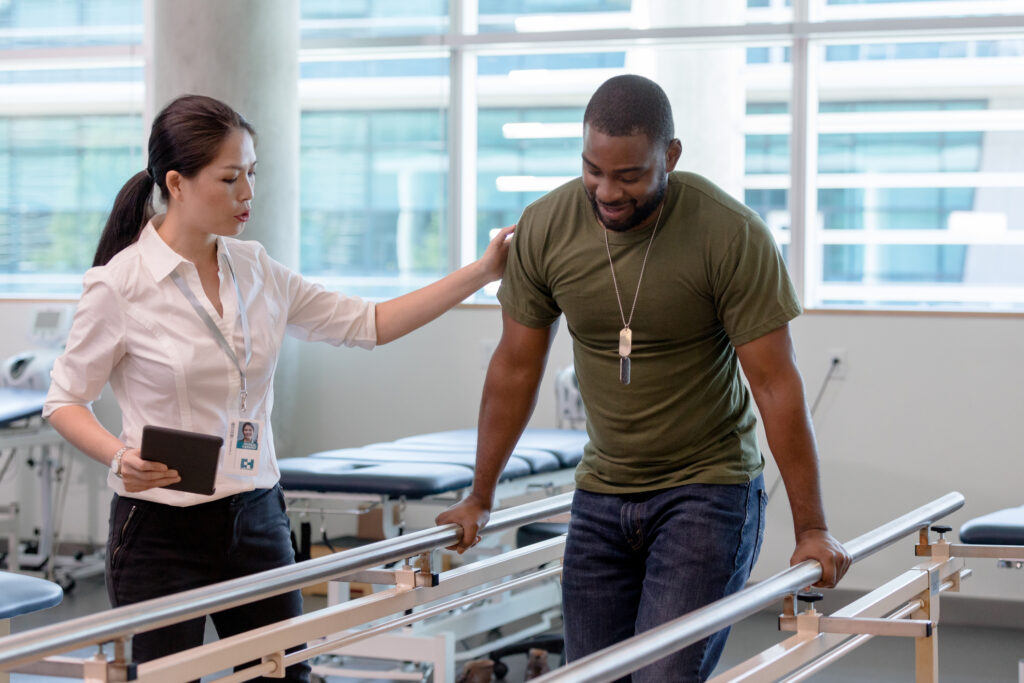Supporting Veterans Through OT

Veterans Day stands as a poignant holiday dedicated to the service and sacrifices made by countless men and women. It also is a good reminder of society’s promise to support them as they return to civilian life. Occupational therapy (OT) can play a vital role in assisting veterans as they regain independence, restore well-being, and rebuild lives.
OT has been helping veterans live their lives more independently since 1917. One famous example is Sergeant Harold Russell, who lost both hands in World War II; through rigorous OT, he relearned daily life tasks, including being able to smoke a cigarette independently. (It was a different time; smoking was encouraged.)
A person-centered therapy, OT can retrain individuals in everyday skills, help them improve their movement and memory with exercises, coach them on how to modify their home or workplace for better access, and advise their loved ones on how to help.
Here are three specific areas where OT can support veterans’ health and wellbeing.
1. Traumatic brain disorder (TBI) TBI has been called the “signature injury” of the Iraq and Afghanistan wars, with over 17% of post-9/11 veterans being diagnosed with it. TBI occurs when the head or body receives a forceful bump, blow, or jolt; it can also happen due to an object piercing the brain. TBI can interfere with normal brain function and change how a person thinks, communicates, moves, and acts. Ways that OT can help with TBI recovery are:
- setting expectations for realistic recovery goals
- teaching new thinking strategies or training in habits to assist with cognitive recovery
- improving motor and visual special skills for daily activities and interaction
- creating visual cues to aid attention, tracking, remembering, and following through
2. Post-traumatic stress disorder (PTSD) PTSD, also known known as “shell shock” after World War I and “combat fatigue” post-World War II, causes intense, disturbing thoughts and feelings related to traumatic events. Approximately 7% of veterans experience PTSD from being in a war zone, witnessing training accidents, or experiencing military sexual trauma. Many individuals with TBI also have PTSD. As part of a multidisciplinary approach, OT can reduce the daily impact of PTSD. Some OT approaches for PTSD include:
- assessing the types of challenges experienced
- teaching evidence-based, non-pharmaceutical ways of coping with stress, pain, sleep disruption, and other issues
- identifying meaningful activities for replacing unhealthy activities
- assisting with safe driving strategies, which can be dangerous for PTSD sufferers
3. Prosthetics A prosthetic is a device that supports or replaces a body part or function, for purposes such as increased mobility, vision, and hearing. More than half of veterans in the Veterans Affairs (VA) healthcare system will rely on a prosthetic during their lifespan, from hearing aids to artificial limbs. The VA alone treats about 100,000 veterans with amputations, half of which are major limb amputations. OT can assist veterans with prosthetics by:
- redesigning activities to accommodate independence with the prosthetic
- suggesting home modifications for safety and mobility
- advising on small purchases to aid daily activities like dressing and eating as well as large purchases such as wheelchairs or furniture
- building confidence with strategies to address fatigue and role changes
Honoring veterans means giving them the healthcare they need to live the life they want. CPT is here to support our veterans in that quest.
![CPT Rehab [logo]](https://www.cptrehab.com/wp-content/themes/cpt-rehab/images/logo.png)